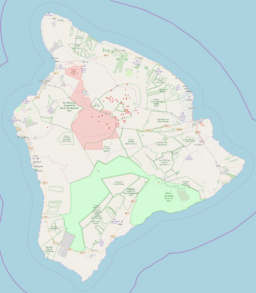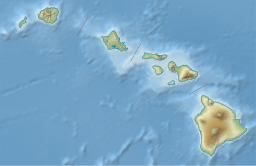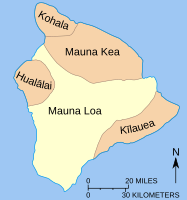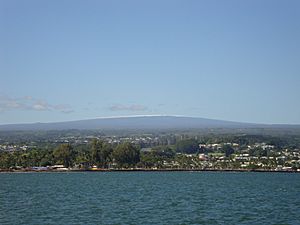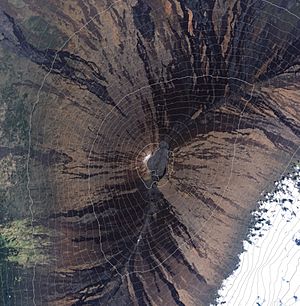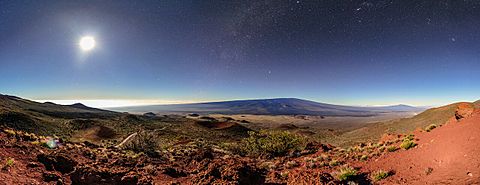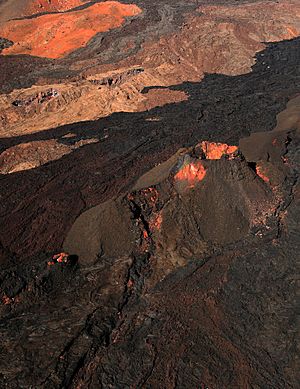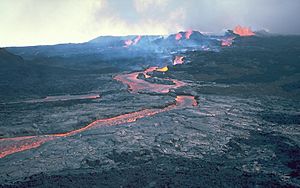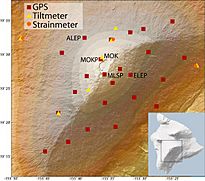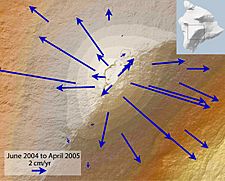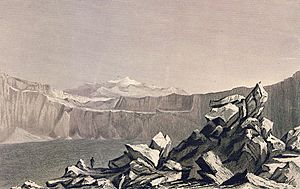Mauna Loa facts for kids
Quick facts for kids Mauna Loa |
|
|---|---|

Mauna Loa seen from the air. You can see Hualālai in the background.
|
|
| Highest point | |
| Elevation | 13,679 ft (4,169 m) |
| Prominence | 7,079 ft (2,158 m) |
| Listing | |
| Geography | |
| Parent range | Hawaiian Islands |
| Topo map | USGS Mauna Loa |
| Geology | |
| Age of rock | 700,000–1 million |
| Mountain type | Shield volcano |
| Volcanic arc/belt | Hawaiian-Emperor seamount chain |
| Last eruption | November 27, 2022 - December 13, 2022 |
| Climbing | |
| First ascent | Ancient times |
| Easiest route | Ainapo Trail |
Mauna Loa (which means "Long Mountain" in Hawaiian) is one of five volcanoes that make up the Island of Hawaii in the U.S. state of Hawaii. It is located in the Pacific Ocean. Mauna Loa is the Earth's largest active volcano by both its size and how much rock it contains.
This volcano is a shield volcano, which means it has gentle slopes. Its peak is a bit lower than its neighbor, Mauna Kea. When Mauna Loa erupts, the lava is very fluid and usually flows out gently, not in big explosions.
Scientists believe Mauna Loa has been erupting for at least 700,000 years. It might have risen above the ocean about 400,000 years ago. The lava comes from the Hawaii hotspot, a special place deep in the Earth. This hotspot has created the entire Hawaiian island chain over millions of years.
Mauna Loa's most recent eruption happened from November 27 to December 13, 2022. This was its first eruption since 1984. Luckily, no one has died in recent eruptions. However, past eruptions in 1926 and 1950 destroyed villages. The city of Hilo is partly built on old lava flows from the late 1800s.
Because Mauna Loa can be dangerous to nearby towns, it is part of the Decade Volcanoes program. This program encourages scientists to study the world's most risky volcanoes. The Hawaiian Volcano Observatory has been watching Mauna Loa closely since 1912. There are also observatories near the summit that study the atmosphere and the Sun. Hawaii Volcanoes National Park covers the top of Mauna Loa and parts of its sides. It also includes Kīlauea, another volcano.
Contents
How Mauna Loa Was Formed
Volcano's Location and Creation
Like all Hawaiian volcanoes, Mauna Loa was formed by the Pacific tectonic plate moving over a hot spot in the Earth's deep mantle. This process has been going on for over 70 million years. It created the long Hawaiian–Emperor seamount chain of islands and underwater mountains. Scientists believe this hot spot has mostly stayed in the same place.
Mauna Loa is one of five volcanoes that make up the island of Hawaiʻi. The oldest volcano on the island, Kohala, is over a million years old. Kīlauea, the youngest, is about 210,000 to 280,000 years old. Mauna Loa is the second youngest of the five volcanoes on the island. It is part of a long chain of volcanoes and seamounts that stretches to Russia.
Mauna Loa started as an underwater volcano. It slowly grew bigger through eruptions of lava under the sea. It finally rose above the ocean about 400,000 years ago. Since then, the volcano has been active. It has erupted many times, including 34 times since the first recorded eruption in 1843.
What Mauna Loa Looks Like
Mauna Loa is the largest volcano on land and the second largest overall in the world. It covers an area of about 5,271 square kilometers (2,035 square miles). It makes up more than half of the island of Hawaiʻi. From its base on the ocean floor to its summit, Mauna Loa rises about 9,170 meters (30,085 feet). This is even taller than Mount Everest if you measure Everest from sea level! Also, the volcano's weight pushes the Earth's crust down by another 8 kilometers (5 miles). This means its total height from its very beginning is about 17,170 meters (56,332 feet).
Mauna Loa is a typical shield volcano. It looks like a wide, gentle dome that stretches down to the ocean. Its sides are not very steep, which is because its lava is very fluid. At the top of Mauna Loa, there are three overlapping craters. Together, these form the large summit caldera called Mokuʻāweoweo. This caldera was formed about 1,000 to 1,500 years ago. A big eruption emptied a shallow magma chamber below, causing the ground to collapse.
The summit of Mauna Loa also has two main rift zones. These are long cracks in the volcano's surface where lava often erupts. One rift zone goes southwest towards the sea. The other goes northeast towards Hilo. These rift zones are deep structures where magma pushes up from below.
Scientists use special tools to study the magma chamber under Mauna Loa. They believe it is about 1.1 kilometers (0.7 miles) wide and about 4.7 kilometers (2.9 miles) deep. This shallow magma chamber helps explain why lava often erupts from the rift zones.
Mauna Loa interacts with its neighbors, Hualālai, Mauna Kea, and especially Kīlauea. Lava from Mauna Kea flows under Mauna Loa because Kea is older. Kīlauea is very close to Mauna Loa. For a long time, people thought Kīlauea was just a part of Mauna Loa. But scientists now know they have separate magma chambers.
Interestingly, when one volcano is very active, the other often has less activity. For example, when Kīlauea was quiet from 1934 to 1952, Mauna Loa was active. But this isn't always true. The 1984 eruption of Mauna Loa happened while Kīlauea was also erupting.
Mauna Loa is so tall that it had glaciers during the last ice age, about 25,000 to 15,000 years ago. Unlike Mauna Kea, Mauna Loa has been active since then. New lava flows have covered any old glacial deposits.
Volcano's Eruptions
Past Eruptions
Mauna Loa has grown very quickly to its huge size. This means it must have erupted a lot throughout its history. Scientists have used radiocarbon dating of old charcoal found in lava flows to learn about nearly 200 past eruptions.
The oldest lava flows visible on Mauna Loa are about 100,000 to 200,000 years old. There's also a layer of ash called the Pāhala ash layer. This ash was created between 13,000 and 30,000 years ago. It might have formed when lava met the glaciers that were on Mauna Loa during the last ice age.
Studies show that Mauna Loa has a cycle of activity. For several hundred years, eruptions happen mostly at the summit. Then, activity shifts to the rift zones for several more centuries, and then back to the summit. This cycle lasts about 1,500 to 2,000 years.
Recent Eruptions
Ancient Hawaiians lived on the island for about 1,500 years. They didn't write much about volcanic activity. The first fully confirmed eruption witnessed by people from other countries was in January 1843. Since then, Mauna Loa has erupted 32 times.
Historical eruptions at Mauna Loa are usually gentle. They often start with lava fountains erupting along a long crack, like a "curtain of fire." This usually happens at the summit first, then moves to a single vent. After summit activity, eruptions on the volcano's sides (flanks) often follow a few months later. Mauna Loa erupts less often than Kilauea, but it usually produces more lava in a shorter time.
Most eruptions happen at the summit or along its two main rift zones. About 38% of eruptions happened at the summit, 31% at the northeast rift zone, and 25% at the southwest rift zone.
In 1859, one of the largest historical flows happened on Mauna Loa's northwestern side. It produced a long lava flow that reached the ocean on the west coast of Hawaii island. An eruption in 1868 happened at the same time as a huge earthquake. This earthquake was a magnitude eight event and killed 77 people.
Mauna Loa was very active from August 1872 to 1877. This was a long eruption that lasted about 1,200 days and stayed at the summit. A short eruption in 1877 was unusual because it happened underwater in Kealakekua Bay. People in boats saw turbulent water and floating pieces of hardened lava. Further eruptions happened in 1879 and twice in 1880. The 1880 eruption flowed close to the city of Hilo, but the town was further down the slope then, so it was safe.

In 1926, an eruption was especially notable. It destroyed a village near Hoʻōpūloa, including 12 houses, a church, and a small harbor. In 1935, Mauna Loa's eruption caused concern when lava flows headed towards Hilo. The military tried to divert the flows by bombing them. The bombing was declared a success, but scientists still debate if it actually stopped the lava.
The 1942 eruption happened during World War II. Because of a wartime blackout, the government tried to keep the eruption a secret. They feared the Japanese would use the bright glow to bomb the island. However, when lava flows threatened a water source, the U.S. Army Air Force dropped bombs to try and redirect the lava. This had little effect, and the eruption stopped on its own.
The next major eruption was in 1950. This was the biggest rift eruption in modern history. It lasted 23 days and produced a huge amount of lava. The lava reached the ocean, 24 kilometers (15 miles) away, in just 3 hours. Flows covered the village of Hoʻokena-mauka and a main highway. No lives were lost, but the village was completely destroyed.
After 1950, Mauna Loa was quiet for a long time, except for a small eruption in 1975. It erupted again in 1984. Lava flowed towards Hilo, coming within 6 kilometers (4 miles) of the city. It was close enough to light up the city at night. But the flow stopped when natural barriers broke and sent the lava in another direction.
From 1985 to 2022, Mauna Loa had its longest quiet period in recorded history. Magma was building up beneath the volcano. Scientists noticed signs of unrest since 2019, but an eruption wasn't expected right away.
The quiet period ended on November 27, 2022. An eruption began at the summit in Mokuʻāweoweo. Lava flows were visible from Kailua-Kona. The eruption then moved to the Northeast Rift Zone. Lava fountains shot up to 200 feet (60 meters) into the air. The lava flows cut off the road to the Mauna Loa Observatory.
As the eruption continued, signs of it slowing down appeared. By December 8, the lava flows began to drain and stopped moving. The Hawaiian Volcano Observatory lowered the alert level on December 10. The eruption officially ended on December 13, 2022.
Dangers from Mauna Loa
Mauna Loa is a Decade Volcano. This means it's one of 16 volcanoes chosen for special study because of their history of big, destructive eruptions and their closeness to populated areas. The United States Geological Survey has a map that shows danger zones on the island. Zone one is the most dangerous, covering Mauna Loa's active summit and rift zones.
Volcanic eruptions in Hawaiʻi rarely cause deaths. However, lava flows can cause a lot of property damage. Hawaiian-type eruptions usually produce very slow-moving lava. This lava moves at walking pace, so people can usually get away. But Mauna Loa's 1950 eruption was different. It produced a huge amount of lava very quickly, reaching the ocean in just four hours. It destroyed a village and a highway. The 1926 eruption also destroyed a village. Hilo, which is partly built on old lava flows, is at risk from future eruptions.
A bigger danger from Mauna Loa is a sudden, huge collapse of its sides. This happened about 100,000 to 200,000 years ago, forming Kealakekua Bay. Large fault lines are common on Hawaiian volcanoes. These allow parts of the volcano's sides to slowly slide downwards. Big earthquakes could cause these slides to happen very quickly. This could create massive landslides and possibly huge tsunamis. Underwater surveys have found many landslides along the Hawaiian island chain. There is evidence of two giant tsunami events in the past.
Watching the Volcano
The Hawaiian Volcano Observatory (HVO) was started in 1912. It is the main group that watches and studies Hawaiian volcanoes. The HVO has been watching Mauna Loa closely since then.
Eruptions on Mauna Loa are almost always preceded by a lot of earthquake activity. In the past, watching these earthquakes was the main way to predict eruptions. Seismic stations have been on Hawaiʻi since the HVO started. More modern equipment was installed in the 1970s. For example, the 1975 eruption was predicted by over a year of earthquake activity. The 1984 eruption was also predicted by three years of high seismic activity.
Today, the monitoring system uses more than just seismic stations. It also has many GPS stations, tiltmeters, and strainmeters. These tools measure how the ground changes shape as magma builds up under the volcano. This gives scientists a better idea of when an eruption might happen. The HVO also has gas detectors at the summit and a live webcam that anyone can watch.
Human History
Early Hawaiian Life
The first Ancient Hawaiians who came to Hawaii island lived near the shores. There was plenty of food and water there. They hunted flightless birds and introduced new plants and animals. This changed the local environment.
Ancient Hawaiian religious beliefs say that the five volcanic peaks on the island are sacred. Mauna Loa, being the largest, was greatly admired. Many stories say the Hawaiian volcano goddess, Pele, lives in Halemaʻumaʻu on Kilauea. But some stories also place her home at Mauna Loa's summit caldera, Mokuʻāweoweo.
Ancient Hawaiians built a large system of trails on Hawaiʻi island, now called the Ala Kahakai National Historic Trail. One of these trails, the Ainapo Trail, went all the way up to Mauna Loa's summit. It was a tough journey, taking several days. Ancient Hawaiians likely used this trail during eruptions to leave offerings and prayers for Pele.
First European Climbs
James Cook's third voyage was the first to land on Hawaiʻi island in 1778. In 1779, John Ledyard, a marine, tried to climb Mauna Loa. He wanted to explore the snowy peak. But the route was too steep and thick with plants, so he had to turn back.
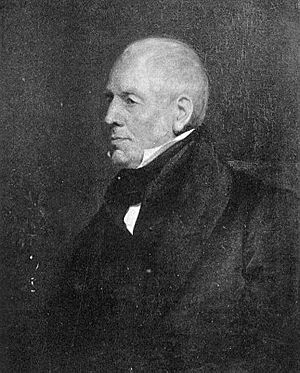
The next attempt was by Archibald Menzies, a botanist, in 1793. He tried twice but was stopped by thick forests. In February 1794, Menzies made a third attempt. This time, he asked King Kamehameha I for advice. He learned about the ʻAinapō Trail. Better prepared, Menzies and his group reached the summit. He estimated its height to be about 4,156 meters (13,635 feet), which is very close to the modern measurement. He was surprised to find heavy snow and cold temperatures.
The feat of reaching Mauna Loa's summit was not repeated for 40 years. Missionaries arrived in Hawaii in the 1820s. Some observed Mauna Loa from a distance, but didn't try to climb it.
The next successful climb was on January 29, 1834, by the Scottish botanist David Douglas. He also used the ʻAinapō Trail. He stayed overnight at the summit to take measurements. Douglas collected plant samples on his way up and down.
Isidor Löwenstern successfully climbed Mauna Loa in February 1839. This was only the third successful climb in 60 years.
Wilkes Expedition's Climb
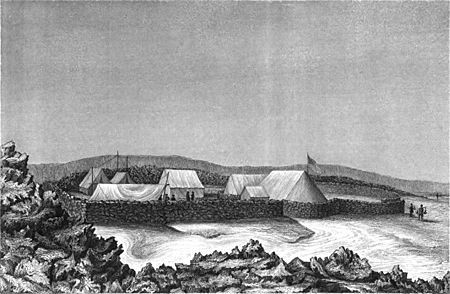
The United States Exploring Expedition, led by Lieutenant Charles Wilkes, arrived in Hawaii in 1840. Wilkes decided to climb Mauna Loa first, thinking it would be easier than Mauna Kea. On December 14, he hired about 200 porters to carry equipment.
Wilkes didn't want to follow the established ʻAinapō Trail. Instead, he decided to make his own path through the dense forest. This upset the Hawaiians because it meant cutting down sacred trees. After two days, they set up a camp called "Sunday Station."
Two guides joined them, but Wilkes realized they were less than halfway up. Porters had to go back a long way to get water. After more hiking, they set up "Recruiting Station" and then "Flag Station." By this time, they were on the ʻAinapō Trail.
At Flag Station, Wilkes and his eight men built a circular wall of lava rocks for shelter. A snowstorm hit, and some men got altitude sickness. It took another week to bring all the equipment to the summit, including a special pendulum to measure gravity.
On December 31, 1840, they set up the pendulum house. It took three more days to get the equipment ready for experiments. But strong winds made it hard to hear the clock and affected temperature readings.
On January 11, 1841, Wilkes hiked around the summit crater. He estimated Mauna Kea was a bit taller than Mauna Loa. On January 13, he carved "Pendulum Peak, January 1841 U.S. Ex, Ex." into a rock. The expedition then packed up and left the island on March 5. Despite all the effort, Wilkes didn't get important scientific results.
The ruins of Wilkes' campsite are the only known physical evidence of the U.S. Exploring Expedition in the Pacific. It is now a historic site.
Mauna Loa Today
A shelter was built at the summit in 1934 using some stones from Wilkes' camp. In 1916, Mokuʻāweoweo was included in Hawaii Volcanoes National Park. A new trail was built directly from the park headquarters at Kīlauea. This trail, coming from the east, became the most popular route because it was easier. The historic ʻAinapō Trail was reopened in the 1990s. Another modern route goes from Saddle Road up to the Mauna Loa Observatory.
Climate Around Mauna Loa
Trade winds blow from east to west across the Hawaiian islands. Mauna Loa greatly affects the weather. On the eastern (windward) side of the volcano, there is heavy rain. Hilo is one of the wettest cities in the United States. This rain helps grow thick forests. The western (leeward) side is much drier.
Higher up on the volcano, there is less rain, and the skies are often clear. Temperatures are very low, so precipitation often falls as snow. The summit of Mauna Loa is a "periglacial" region, meaning freezing and thawing play a big role in shaping the land.
Mauna Loa has a tropical climate at lower elevations, with warm temperatures year-round. Higher up, it gets cool to cold. The table below shows the climate at the slope observatory, which is at 3,400 meters (11,150 feet). The highest temperature recorded there was 78°F (26°C), and the lowest was 18°F (-8°C).
| Climate data for Mauna Loa slope observatory 3,400 meters (11,150 feet) (1981–2010 normals, extremes 1955–present) | |||||||||||||
|---|---|---|---|---|---|---|---|---|---|---|---|---|---|
| Month | Jan | Feb | Mar | Apr | May | Jun | Jul | Aug | Sep | Oct | Nov | Dec | Year |
| Record high °F (°C) | 67 (19) |
69 (21) |
66 (19) |
67 (19) |
68 (20) |
71 (22) |
70 (21) |
69 (21) |
78 (26) |
68 (20) |
65 (18) |
67 (19) |
78 (26) |
| Mean daily maximum °F (°C) | 51.9 (11.1) |
51.2 (10.7) |
51.9 (11.1) |
53.2 (11.8) |
55.8 (13.2) |
58.5 (14.7) |
57.5 (14.2) |
57.9 (14.4) |
56.7 (13.7) |
55.7 (13.2) |
53.2 (11.8) |
52.0 (11.1) |
54.6 (12.6) |
| Daily mean °F (°C) | 43.6 (6.4) |
42.4 (5.8) |
43.1 (6.2) |
44.3 (6.8) |
47.1 (8.4) |
49.3 (9.6) |
48.6 (9.2) |
49.1 (9.5) |
48.1 (8.9) |
47.3 (8.5) |
46.1 (7.8) |
44.1 (6.7) |
46.1 (7.8) |
| Mean daily minimum °F (°C) | 35.3 (1.8) |
33.7 (0.9) |
34.2 (1.2) |
35.3 (1.8) |
38.4 (3.6) |
40.2 (4.6) |
39.6 (4.2) |
40.2 (4.6) |
39.4 (4.1) |
38.8 (3.8) |
38.9 (3.8) |
36.2 (2.3) |
37.5 (3.1) |
| Record low °F (°C) | 19 (−7) |
18 (−8) |
20 (−7) |
23 (−5) |
27 (−3) |
28 (−2) |
26 (−3) |
28 (−2) |
29 (−2) |
27 (−3) |
25 (−4) |
21 (−6) |
18 (−8) |
| Average precipitation inches (mm) | 2.48 (63) |
1.51 (38) |
1.75 (44) |
1.33 (34) |
1.00 (25) |
0.51 (13) |
1.16 (29) |
1.50 (38) |
1.36 (35) |
1.16 (29) |
1.78 (45) |
2.01 (51) |
17.55 (446) |
| Average snowfall inches (cm) | 0.0 (0.0) |
1.0 (2.5) |
0.3 (0.76) |
1.3 (3.3) |
0.0 (0.0) |
0.0 (0.0) |
0.0 (0.0) |
0.0 (0.0) |
0.0 (0.0) |
0.0 (0.0) |
0.0 (0.0) |
1.0 (2.5) |
3.7 (9.4) |
| Average precipitation days (≥ 0.01 in) | 4 | 5 | 6 | 5 | 4 | 3 | 4 | 5 | 5 | 5 | 5 | 4 | 55 |
| Source 1: NOAA | |||||||||||||
| Source 2: Western Climate Center (precipitation and snow 1955–2005) | |||||||||||||
Science Observatories
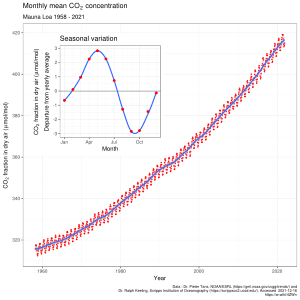
Mauna Loa's location is perfect for studying the atmosphere and other scientific observations. The Mauna Loa Solar Observatory (MLSO) is on the northern slope. It has been important for observing the Sun. The NOAA Mauna Loa Observatory (MLO) is also nearby. From its high location, away from city pollution, the MLO watches the global atmosphere. This includes measuring greenhouse gases like carbon dioxide.
The Yuan-Tseh Lee Array for Microwave Background Anisotropy (AMiBA) is also located on Mauna Loa. It was set up in 2006 to study cosmic microwave background radiation, which is leftover energy from the Big Bang.
Images for kids
 In Spanish: Mauna Loa para niños
In Spanish: Mauna Loa para niños
- HI-SEAS
- List of mountain peaks of the United States
- List of Ultras of Oceania
- List of Ultras of the United States
- Olympus Mons – The largest volcano in the Solar System


